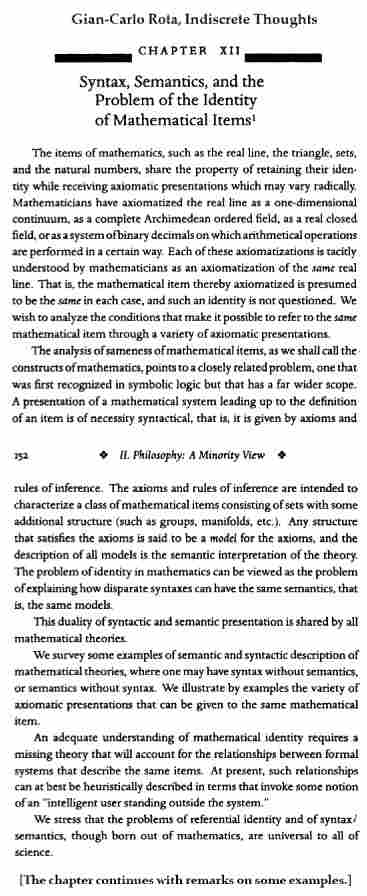For Women's History Month —
Thursday, March 24, 2016
Many Dimensions…
Friday, September 20, 2024
Ring and Stone
|
The Ring and the Stone
From Many Dimensions, a novel "This Holy Thing has been kept in seclusion," Ibrahim answered, "through many centuries, and in all that time none of its keepers have approached or touched it. And since Giles Tumulty stole it men have grasped at it in their own wisdom. But this woman has put her will at its disposal, and between it and her the union may be achieved by which the other Hiddenness is made manifest." "What is the other Hiddenness?" Lord Arglay asked. The Hajji hesitated, then he turned his eyes back to Chloe and seemed to ask a question of her. What answer he saw on the forehead at which he gazed she could not guess, but he spoke then in a low and careful voice. "In the Crown of Suleiman the Wise-the Peace be upon him!-" he said, "there was a Stone, and this Stone was that which is the First Matter of Creation, holy and terrible. But on the hand of the King there was a Ring and in the Ring was another secret, more holy and terrible than the Stone. For within the Ring there was a point of that Light which is the Spirit of Creation, the Adornment of the Unity, the Knowledge of the Loveliness, the Divine Image in the mirror of the worlds just and true. This was the justice and the Wisdom of Suleiman, by which all souls were made manifest to him and all causes rightly determined. Also when within the Holy of Holies in the Temple that the King made he laid his crown upon the Ark and between the wings of the Cherubim, and held his hand over it, the Light of the Ring shone upon the Stone and all things had peace. But when the King erred, building altars to strange gods, he dared no longer let the Light fall upon the Stone; also he put aside the Ring and it is told that Asmodeus sat upon his throne seven years. But I think that perhaps the King himself had not all that time parted from his throne, how closely soever Asmodeus dwelt within his soul. And of the hiding place of the Ring I do not know, nor any of my house; if it is on earth it is very secret. But the Light of it is in the Stone and all the Types of the Stone-and the Power of it is in the soul and body of any who have sought the union with the Stone, so that whoever touches them in anger or hatred or evil desire is subjected to the Light and Power of the Adornment of the Unity. And this I think my nephew did, and this is the cause of his blasting and hurling out." He looked straight at Chloe. "But woe, woe, woe to you," he said, "if from this time forth for ever you forget that you gave your will to the Will of That which is behind the Stone." |
This post was suggested by a Friday the Thirteenth death.
Tuesday, November 8, 2022
Wednesday, February 23, 2022
Friday, February 11, 2022
De Beer’s Consolidated Mine
The misleading image at right above is from the cover of
an edition of Charles Williams's classic 1931 novel
Many Dimensions published in 1993 by Wm. B. Eerdmans.
But seriously . . .
Tuesday, February 16, 2021
Buffalo Logic
From a post of January 8, 2021 —
“Lord Arglay had a suspicion that the Stone would be
purely logical. Yes, he thought, but what, in that sense,
were the rules of its pure logic?”
—Many Dimensions (1931), by Charles Williams

A Midrash for Emma —

Friday, January 8, 2021
Welcome to Zombieland

“Lord Arglay had a suspicion that the Stone would be
purely logical. Yes, he thought, but what, in that sense,
were the rules of its pure logic?”
—Many Dimensions (1931), by Charles Williams

“Don’t give a damn ’cause I done that already.” — Zombie Jamboree
Wednesday, April 22, 2020
One with Everything
The title is of course from an old joke about mystic philosophies.
Related remarks by John Archibald Wheeler —
“Remarkable issues connected with the puzzle of existence
confront us today in Hermann Weyl’s domain of thought.
Four among them I bring before you here as especially interesting:
(1) What is the machinery of existence?
(2) What is deeper foundation of the quantum principle?
(3) What is the proper position to take about the existence of
the “continuum” of the natural numbers? And
(4) What can we do to understand time as an entity, not precise and
supplied free of charge from outside physics, but approximate and
yet to be derived from within a new and deeper time-free physics?
In brief, how come time?
What about the continuum?
How come the quantum?
What is existence?”
— John A. Wheeler, “Hermann Weyl and the Unity of Knowledge,”
American Scientist 74, no. 4 (1986): 366–75. Reprinted in
John A. Wheeler, At Home in the Universe
(American Institute of Physics, December 1, 1995).
The above bibliographic data is from . . .
Schrank, Jeffrey. Inventing Reality: Stories We Create To Explain Everything .
Gatekeeper Press. Kindle Edition, March 14, 2020.
For further scholarly details, see a version at JSTOR:
“…the article is adapted from the concluding address given at
the Hermann Weyl Centenary Congress, University of Kiel, 3 July 1985.”
— https://www.jstor.org/stable/27854250.
I prefer Charles Williams on “the Unity of Knowledge.”
See the 15 instances of the phrase “the Unity” in his 1931 novel Many Dimensions .
Wednesday, January 29, 2020
On the Road
From Mosaic Logic, a post of September 3, 2017 —
“Lord Arglay had a suspicion that the Stone would be
purely logical. Yes, he thought, but what, in that sense,
were the rules of its pure logic?”
—Many Dimensions (1931), by Charles Williams

Sunday, November 17, 2019
E-Elements Revisited
The German mathematician Wolf Barth in the above post is not the
same person as the Swiss artist Wolf Barth in today's previous post.
An untitled, undated, picture by the latter —
Compare and contrast with an "elements" picture of my own —
— and with . . .
“Lord Arglay had a suspicion that the Stone would be
purely logical. Yes, he thought, but what, in that sense,
were the rules of its pure logic?”
—Many Dimensions (1931), by Charles Williams
Monday, November 11, 2019
Time and Chance

The misleading image at right above is from the cover of
an edition of Charles Williams's classic 1931 novel
Many Dimensions published in 1993 by Wm. B. Eerdmans.
Compare and constrast —
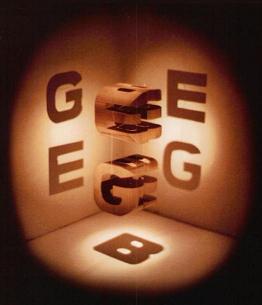
Cover of a book by Douglas Hofstadter
Sunday, July 15, 2018
Jewish Oases
"… Lincoln Plaza Cinemas, the Juilliard String Quartet,
and the Strand Book Store remained oases
for cultural and intellectual stimulation."
— John S. Friedman in The Forward , Jan. 21, 2018
Read more:
https://forward.com/culture/392483/
how-fred-bass-dan-talbot-robert-mann
-shaped-new-york-culture/
From the Oasis in Steven Spielberg's "Ready Player One" (2018) —
I prefer, from a Log24 search for Flux Capacitor …
From "Raiders of the Lost Images" —
"The cube shape of the lost Mother Box,
also known as the Change Engine,
is shared by the Stone in a novel by
Charles Williams, Many Dimensions .
See the Solomon's Cube webpage."
Saturday, May 19, 2018
Flux Capacitor
For Tom Hanks and Dan Brown —
From "Raiders of the Lost Images" —
"The cube shape of the lost Mother Box,
also known as the Change Engine,
is shared by the Stone in a novel by
Charles Williams, Many Dimensions .
See the Solomon's Cube webpage."
See as well a Google search for flux philosophy —
https://www.google.com/search?q=flux+philosophy.
Tuesday, February 27, 2018
Raiders of the Lost Images
On the recent film "Justice League" —
From DC Extended Universe Wiki, "Mother Box" —
"However, during World War I, the British rediscovered
mankind's lost Mother Box. They conducted numerous studies
but were unable to date it due to its age. The Box was then
shelved in an archive, up until the night Superman died,
where it was then sent to Doctor Silas Stone, who
recognized it as a perpetual energy matrix. . . ." [Link added.]
The cube shape of the lost Mother Box, also known as the
Change Engine, is shared by the Stone in a novel by Charles Williams,
Many Dimensions . See the Solomon's Cube webpage.
See too the matrix of Claude Lévi-Strauss in posts tagged
Verwandlungslehre .
Some literary background:
Who speaks in primordial images speaks to us
as with a thousand trumpets, he grips and overpowers,
and at the same time he elevates that which he treats
out of the individual and transitory into the sphere of
the eternal. — C. G. JUNG
"In the conscious use of primordial images—
the archetypes of thought—
one modern novelist stands out as adept and
grand master: Charles Williams.
In The Place of the Lion he incarnates Plato’s
celestial archetypes with hair-raising plausibility.
In Many Dimensions he brings a flock of ordinary
mortals face to face with the stone bearing
the Tetragrammaton, the Divine Name, the sign of Four.
Whether we understand every line of a Williams novel
or not, we feel something deep inside us quicken
as Williams tells the tale.
Here, in The Greater Trumps , he has turned to
one of the prime mysteries of earth . . . ."
— William Lindsay Gresham, Preface (1950) to
Charles Williams's The Greater Trumps (1932)
For fans of what the recent series Westworld called "bulk apperception" —
Sunday, September 3, 2017
Mosaic Logic
“Lord Arglay had a suspicion that the Stone would be
purely logical. Yes, he thought, but what, in that sense,
were the rules of its pure logic?”
—Many Dimensions (1931), by Charles Williams

While you're waiting …
Click the above illustration for
some remarks on mosaics.
Sunday, August 13, 2017
Logos
In memoriam —
Zadeh is known for the unfortunate phrase "fuzzy logic."
Not-so-fuzzy related material —
“Lord Arglay had a suspicion that the Stone would be
purely logical. Yes, he thought, but what, in that sense,
were the rules of its pure logic?”
—Many Dimensions (1931), by Charles Williams
Monday, June 12, 2017
Bubble
The "bubble" passage in the previous post suggests a review of
a post from December 21, 2006, with the following images —


Update of 11:01 PM ET the same day, June 12, 2017 —
Related material for the Church of Synchronology —
From a tech-article series that began on Halloween 2006 and
ended on the date of the above Geometry's Tombstones post —



Compare and contrast (from a post of Feb. 27, 2017) —
“Lord Arglay had a suspicion that the Stone would be
purely logical. Yes, he thought, but what, in that sense,
were the rules of its pure logic?”
—Many Dimensions (1931), by Charles Williams
See also "The Geometry of Logic:
Finite Geometry and the 16 Boolean Connectives"
by Steven H. Cullinane in 2007.
Monday, February 27, 2017
Logic for Jews
Adam Gopnik in The New Yorker today reacts to the startling
outcomes of three recent contests: the presidential election,
the Super Bowl, and the Oscar for Best Picture —
"The implicit dread logic is plain."
Related material —
Transformers in this journal and …
“Lord Arglay had a suspicion that the Stone would be
purely logical. Yes, he thought, but what, in that sense,
were the rules of its pure logic?”
—Many Dimensions (1931), by Charles Williams
See also …
The above figure is from Ian Stewart's 1996 revision of a 1941 classic,
What Is Mathematics? , by Richard Courant and Herbert Robbins.
One wonders how the confused slave boy of Plato's Meno would react
to Stewart's remark that
"The number of copies required to double an
object's size depends on its dimension."
Saturday, January 28, 2017
Cranking It Up
From "Core," a post of St. Lucia's Day, Dec. 13, 2016 —
In related news yesterday —
California yoga mogul’s mysterious death:
Trevor Tice’s drunken last hours detailed
"Police found Tice dead on the floor in his home office,
blood puddled around his head. They also found blood
on walls, furniture, on a sofa and on sheets in a nearby
bedroom, where there was a large bottle of Grey Goose
vodka under several blood-stained pillows on the floor."
See as well an image from "The Stone," a post of March 18, 2016 —
Some backstory —
“Lord Arglay had a suspicion that the Stone would be
purely logical. Yes, he thought, but what, in that sense,
were the rules of its pure logic?”
—Many Dimensions (1931), by Charles Williams
Sunday, April 3, 2016
Logic
See also Stone Logical Dimensions …
“Lord Arglay had a suspicion that the Stone
would be purely logical. Yes, he thought,
but what, in that sense, were the rules of its pure logic?”
—Many Dimensions (1931), by Charles Williams
Wednesday, September 16, 2015
The World as Myth
Three approaches to The World as Myth…
|
From Heinlein's 1985 The Cat Who Walks Through Walls … The World as Myth is a subtle concept. It has sometimes been called multiperson solipsism, despite the internal illogic of that phrase. Yet illogic may be necessary, as the concept denies logic. For many centuries religion held sway as the explanation of the universe- or multiverse. The details of revealed religions differed wildly but were essentially the same: Somewhere up in the sky-or down in the earth-or in a volcano-any inaccessible place- there was an old man in a nightshirt who knew everything and was all powerful and created everything and rewarded and punished… and could be bribed. "Sometimes this Almighty was female but not often because human males are usually bigger, stronger, and more belligerent; God was created in Pop's image. "The Almighty-God idea came under attack because it explained nothing; it simply pushed all explanations one stage farther away. In the nineteenth century atheistic positivism started displacing the Almighty-God notion in that minority of the population that bathed regularly. "Atheism had a limited run, as it, too, explains nothing, being merely Godism turned upside down. Logical positivism was based on the physical science of the nineteenth century which, physicists of that century honestly believed, fully explained the universe as a piece of clockwork. "The physicists of the twentieth century made short work of that idea. Quantum mechanics and Schrodringer's cat tossed out the clockwork world of 1890 and replaced it with a fog of probability in which anything could happen. Of course the intellectual class did not notice this for many decades, as an intellectual is a highly educated man who can't do arithmetic with his shoes on, and is proud of his lack. Nevertheless, with the death of positivism, Godism and Creationism came back stronger than ever. "In the late twentieth century -correct me when I' m wrong, Hilda-Hilda and her family were driven off Earth by a devil, one they dubbed 'the Beast.' They fled in a vehicle you have met, Gay Deceiver, and in their search for safety they visited many dimensions, many universes… and Hilda made the greatest philosophical discovery of all time." "I'll bet you say that to all the girls!" "Quiet, dear. They visited, among more mundane places, the Land of Oz-" I sat up with a jerk. Not too much sleep last night and Dr. Harshaw's lecture was sleep-inducing. "Did you say 'Oz'?" "I tell you three times. Oz, Oz, Oz. They did indeed visit the fairyland dreamed up by L. Frank Baum. And the Wonderland invented by the Reverend Mr. Dodgson to please Alice. And other places known only to fiction. Hilda discovered what none of us had noticed before because we were inside it: The World is Myth. We create it ourselves-and we change it ourselves. A truly strong myth maker, such as Homer, such as Baum, such as the creator of Tarzan, creates substantial and lasting worlds … whereas the fiddlin', unimaginative liars and fabulists shape nothing new and their tedious dreams are forgotten. …. |
|
Friday, November 6, 2009
Where Entertainment is God (continued)
|
Wednesday, May 6, 2015
Narrative Metaphysics
(Continued from Dec. 13, 2014.)
David Lavery's enthusiasm today for the Marvel Comics
"Infinity Stones" suggests a review of The Foundation Stone
mentioned in the post Narrative Metaphysics of 12/13/2014.
See as well "Many Dimensions" in this journal.
Thursday, February 26, 2015
Brit Award
"The Brit Awards are… the British equivalent
of the American Grammy Awards." — Wikipedia
Detail of an image from yesterday's 5:30 PM ET post:

Related material:
From a review: "Imagine 'Raiders of the Lost Ark'
set in 20th-century London, and then imagine it
written by a man steeped not in Hollywood movies
but in Dante and the things of the spirit, and you
might begin to get a picture of Charles Williams's
novel Many Dimensions ."
See also Solomon's Seal (July 26, 2012).
Tuesday, December 4, 2012
December Days
For the Dec. 3rd-4th graduate conference
at the University of Cambridge on
"Occultism, Magic, and the History of Art"—
Four novels by Charles Williams—
See also the life, and Dec. 1st death, of a former Chief Justice of South Africa.
Thursday, September 13, 2012
Backstory
Yesterday's online Los Angeles Times
on a film that inspired recent protests in Cairo—
The film… was shown on June 23
to an audience of less than 10
at a theater on Hollywood Boulevard,
a source familiar with the screening said….
The screening was at The Vine Theater,
which rents itself out for private screenings,
said one person involved in the theater.
An image from this journal on that same day, June 23—

Source: Rudolf Koch, The Book of Signs
For some background on the symbol, see Damnation Morning.
See also Don Henley's Hollywood hymn "Garden of Allah."
Update of 8 PM Sept. 13, 2012—
Other sources give the film's screening date not as June 23,
2012, but rather as June 30, 2012. (BBC News, LAWEEKLY blogs)
The following post from this journal on that date may or
may not have some religious relevance.
| Saturday, June 30, 2012
Filed under: Uncategorized — m759 @ 7:20 PM "… to snare the spirits of mankind in nets of magic" — The aim of the artist, according to Thomas Wolfe Related entertainment— High-minded— Many Dimensions . Not so high-minded— The Cosmic Cube . |
Thursday, July 19, 2012
But Seriously…

For those who prefer fiction:
"Many Dimensions (1931) — An evil antiquarian illegally purchases
the fabled Stone of Suleiman (Williams uses this Muslim form
rather than the more familiar King Solomon) from its Islamic guardian
in Baghdad and returns to England to discover not only that the Stone
can multiply itself infinitely without diminishing the original, but that it
also allows its possessor to transcend the barriers of space and time."
— Wikipedia article on the author Charles Williams
Saturday, June 30, 2012
Snares
"… to snare the spirits of mankind in nets of magic"
— The aim of the artist, according to Thomas Wolfe
Related entertainment—
High-minded— Many Dimensions .
Not so high-minded— The Cosmic Cube .
Friday, June 8, 2012
Cartoon Graveyard
For some background, see "Cartoon Graveyard" and "Many Dimensions."
Wednesday, January 11, 2012
Cuber
"Examples galore of this feeling must have arisen in the minds of the people who extended the Magic Cube concept to other polyhedra, other dimensions, other ways of slicing. And once you have made or acquired a new 'cube'… you will want to know how to export a known algorithm , broken up into its fundamental operators , from a familiar cube. What is the essence of each operator? One senses a deep invariant lying somehow 'down underneath' it all, something that one can’t quite verbalize but that one recognizes so clearly and unmistakably in each new example, even though that example might violate some feature one had thought necessary up to that very moment. In fact, sometimes that violation is what makes you sure you’re seeing the same thing , because it reveals slippabilities you hadn’t sensed up till that time….
… example: There is clearly only one sensible 4 × 4 × 4 Magic Cube. It is the answer; it simply has the right spirit ."
— Douglas R. Hofstadter, 1985, Metamagical Themas: Questing for the Essence of Mind and Pattern (Kindle edition, locations 11557-11572)
See also Many Dimensions in this journal and Solomon's Cube.
Thursday, December 1, 2011
Paranoia Strikes Deep
Tens of Millions of Smartphones Come With Spyware
Preinstalled, Security Analyst Says
Published December 01, 2011 – FoxNews.com
For details, see comments at YouTube.
Related entertainment—
1. Tara Fitzgerald in "New World Disorder" (1999)—

We skipped the light fandango
turned cartwheels 'cross the floor
I was feeling kinda seasick
but the crowd called out for more
2. Tara Fitzgerald in "Broken Glass" (2011)—
And so it was that later
as the miller told his tale
that her face, at first just ghostly,
turned a whiter shade of pale
— Procol Harum song at beginning and end of "The Net" (1995)
“Lord Arglay had a suspicion that the Stone
would be purely logical. Yes, he thought,
but what, in that sense, were the rules of its pure logic?”
—Many Dimensions (1931), by Charles Williams,
quoted here on Kristallnacht 2011
See also, from "The Net"—
Decompiling Wolfenstein

"In Wolfenstein 3D , the player assumes the role of an American soldier
of Polish descent… attempting to escape from the Nazi stronghold of
Castle Wolfenstein." — Wikipedia
Wednesday, November 9, 2011
Polish Logic–
The Big Lukasiewicz
“Lord Arglay had a suspicion that the Stone
would be purely logical. Yes, he thought,
but what, in that sense, were the rules of its pure logic?”
—Many Dimensions (1931), by Charles Williams
See also Łukasiewicz in Wikipedia and Lukasiewicz in this journal.
The latter's Christian references seem preferable to yesterday's
link to a scene from the Coen brothers' film "The Big Lebowski."
For those who prefer a Christ-for-Jews there is
also Harvard's version. See The Crimson Passion.
Monday, August 29, 2011
Many = Six.
A comment today on yesterday's New York Times philosophy column "The Stone"
notes that "Augustine… incorporated Greek ideas of perfection into Christianity."
Yesterday's post here for the Feast of St. Augustine discussed the 2×2×2 cube.
Today's Augustine comment in the Times reflects (through a glass darkly)
a Log24 post from Augustine's Day, 2006, that discusses the larger 4×4×4 cube.
For related material, those who prefer narrative to philosophy may consult
Charles Williams's 1931 novel Many Dimensions . Those who prefer mathematics
to either may consult an interpretation in which Many = Six.
Click image for some background.
Tuesday, May 10, 2011
Groups Acting
The LA Times on last weekend's film "Thor"—
"… the film… attempts to bridge director Kenneth Branagh's high-minded Shakespearean intentions with Marvel Entertainment's bottom-line-oriented need to crank out entertainment product."
Those averse to Nordic religion may contemplate a different approach to entertainment (such as Taymor's recent approach to Spider-Man).
A high-minded— if not Shakespearean— non-Nordic approach to groups acting—
"What was wrong? I had taken almost four semesters of algebra in college. I had read every page of Herstein, tried every exercise. Somehow, a message had been lost on me. Groups act . The elements of a group do not have to just sit there, abstract and implacable; they can do things, they can 'produce changes.' In particular, groups arise naturally as the symmetries of a set with structure. And if a group is given abstractly, such as the fundamental group of a simplical complex or a presentation in terms of generators and relators, then it might be a good idea to find something for the group to act on, such as the universal covering space or a graph."
— Thomas W. Tucker, review of Lyndon's Groups and Geometry in The American Mathematical Monthly , Vol. 94, No. 4 (April 1987), pp. 392-394
"Groups act "… For some examples, see
- The 2×2×2 Cube,
- The Diamond 16 Puzzle,
- The Diamond Theorem, and
- Finite Geometry of the Square and Cube.
Related entertainment—
High-minded— Many Dimensions—

Not so high-minded— The Cosmic Cube—

One way of blending high and low—
The high-minded Charles Williams tells a story
in his novel Many Dimensions about a cosmically
significant cube inscribed with the Tetragrammaton—
the name, in Hebrew, of God.
The following figure can be interpreted as
the Hebrew letter Aleph inscribed in a 3×3 square—
The above illustration is from undated software by Ed Pegg Jr.
For mathematical background, see a 1985 note, "Visualizing GL(2,p)."
For entertainment purposes, that note can be generalized from square to cube
(as Pegg does with his "GL(3,3)" software button).
For the Nordic-averse, some background on the Hebrew connection—
Wednesday, April 20, 2011
Romancing the Cube
It was a dark and stormy night…

— Page 180, Logicomix
“… the class of reflections is larger in some sense over an arbitrary field than over a characteristic zero field.”
– Julia Hartmann and Anne V. Shepler, “Jacobians of Reflection Groups”
For some context, see the small cube in “A Simple Reflection Group of Order 168.”
See also the larger cube in “Many Dimensions” + Whitehead in this journal (scroll down to get past the current post).
That search refers to a work by Whitehead published in 1906, the year at the top of the Logicomix page above—

A related remark on axiomatics that has metaphysical overtones suitable for a dark and stormy night—
“An adequate understanding of mathematical identity requires a missing theory that will account for the relationships between formal systems that describe the same items. At present, such relationships can at best be heuristically described in terms that invoke some notion of an ‘intelligent user standing outside the system.'”
— Gian-Carlo Rota, “Syntax, Semantics, and…” in Indiscrete Thoughts . See also the original 1988 article.
Thursday, December 2, 2010
Caesarian
The Dreidel Is Cast
The Nietzschean phrase "ruling and Caesarian spirits" occurred in yesterday morning's post "Novel Ending."
That post was followed yesterday morning by a post marking, instead, a beginning— that of Hanukkah 2010. That Jewish holiday, whose name means "dedication," commemorates the (re)dedication of the Temple in Jerusalem in 165 BC.
The holiday is celebrated with, among other things, the Jewish version of a die— the dreidel . Note the similarity of the dreidel to an illustration of The Stone* on the cover of the 2001 Eerdmans edition of Charles Williams's 1931 novel Many Dimensions—

For mathematics related to the dreidel , see Ivars Peterson's column on this date fourteen years ago.
For mathematics related (if only poetically) to The Stone , see "Solomon's Cube" in this journal.
Here is the opening of Many Dimensions—
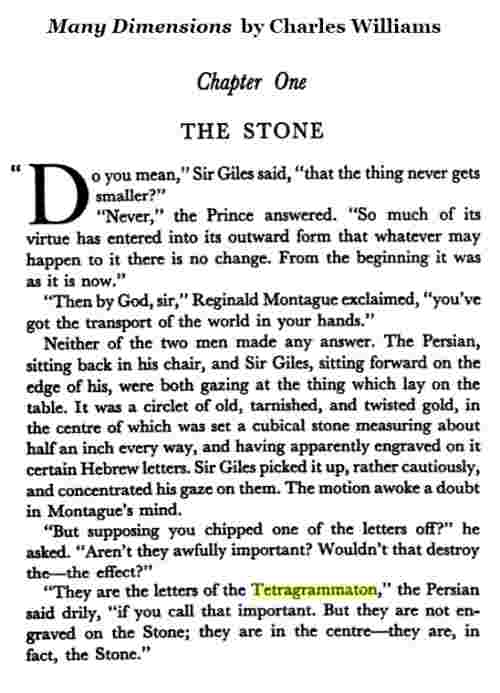
For a fanciful linkage of the dreidel 's concept of chance to The Stone 's concept of invariant law, note that the New York Lottery yesterday evening (the beginning of Hanukkah) was 840. See also the number 840 in the final post (July 20, 2002) of the "Solomon's Cube" search.
Some further holiday meditations on a beginning—
Today, on the first full day of Hanukkah, we may or may not choose to mark another beginning— that of George Frederick James Temple, who was born in London on this date in 1901. Temple, a mathematician, was President of the London Mathematical Society in 1951-1953. From his MacTutor biography—
"In 1981 (at the age of 80) he published a book on the history of mathematics. This book 100 years of mathematics (1981) took him ten years to write and deals with, in his own words:-
those branches of mathematics in which I had been personally involved.
He declared that it was his last mathematics book, and entered the Benedictine Order as a monk. He was ordained in 1983 and entered Quarr Abbey on the Isle of Wight. However he could not stop doing mathematics and when he died he left a manuscript on the foundations of mathematics. He claims:-
The purpose of this investigation is to carry out the primary part of Hilbert's programme, i.e. to establish the consistency of set theory, abstract arithmetic and propositional logic and the method used is to construct a new and fundamental theory from which these theories can be deduced."
For a brief review of Temple's last work, see the note by Martin Hyland in "Fundamental Mathematical Theories," by George Temple, Philosophical Transactions of the Royal Society, A, Vol. 354, No. 1714 (Aug. 15, 1996), pp. 1941-1967.
The following remarks by Hyland are of more general interest—
"… one might crudely distinguish between philosophical and mathematical motivation. In the first case one tries to convince with a telling conceptual story; in the second one relies more on the elegance of some emergent mathematical structure. If there is a tradition in logic it favours the former, but I have a sneaking affection for the latter. Of course the distinction is not so clear cut. Elegant mathematics will of itself tell a tale, and one with the merit of simplicity. This may carry philosophical weight. But that cannot be guaranteed: in the end one cannot escape the need to form a judgement of significance."
— J. M. E. Hyland. "Proof Theory in the Abstract." (pdf)
Annals of Pure and Applied Logic 114, 2002, 43-78.
Here Hyland appears to be discussing semantic ("philosophical," or conceptual) and syntactic ("mathematical," or structural) approaches to proof theory. Some other remarks along these lines, from the late Gian-Carlo Rota—
See also "Galois Connections" at alpheccar.org and "The Galois Connection Between Syntax and Semantics" at logicmatters.net.
* Williams's novel says the letters of The Stone are those of the Tetragrammaton— i.e., Yod, He, Vau, He (cf. p. 26 of the 2001 Eerdmans edition). But the letters on the 2001 edition's cover Stone include the three-pronged letter Shin , also found on the dreidel . What esoteric religious meaning is implied by this, I do not know.
Tuesday, November 23, 2010
Tale
A reviewer says Steve Martin finds in his new novel An Object of Beauty "a sardonic morality tale."
From this journal on the day The Cube was published (see today's Art Object ) —
Monday February 20, 2006
|
See also a post on Mathematics and Narrative from Nov. 14, 2009.
That post compares characters in Many Dimensions to those in Logicomix—
Sunday, November 15, 2009
The Dead Shepherd and…
Chinese Boxes
Continued from “The Dead Shepherd,” Jan. 24, 2007…
“James R. Lilley, 81, a longtime CIA operative in Asia who served as ambassador to China during the Tiananmen Square crackdown… died Nov. 12.”
James R. Lilley
From a page linked to here on the date of Lilley’s death:
“… the extraordinary set of nested Chinese boxes that we introduced earlier in this series….”
A seemingly unrelated item in today’s New York Times obituaries index:
This suggests an article on temporal logic at IBM Developer Works, which contains a link to Time-Rover.com.
This in turn leads to…
Shing’s CV at the Naval Postgraduate School affirms the usefulness of temporal logic.
Those who prefer metaphysics may consult the novel Many Dimensions referred to in yesterday’s entries and in “Relativity Blues” (Feb. 20, 2005)–
From Many Dimensions:
“Lord Arglay had a suspicion that the Stone would be purely logical. Yes, he thought, but what, in that sense, were the rules of its pure logic?”
Saturday, November 14, 2009
Mathematics and Narrative, continued:
A graphic novel reviewed in the current Washington Post features Alfred North Whitehead and Bertrand Russell–
Related material:
Whitehead on Fano's finite projective three-space:
"This is proved by the consideration of a three dimensional geometry in which there are only fifteen points."
—The Axioms of Projective Geometry , Cambridge University Press, 1906
Further reading:
See Solomon's Cube and the link at the end of today's previous entry, then compare and contrast the above portraits of Whitehead and Russell with Charles Williams's portraits of Sir Giles Tumulty and Lord Arglay in the novel Many Dimensions .
Saturday, December 6, 2008
Saturday December 6, 2008
Another Show
A footprint from Germany:
|
Germany Python-urllib |
/504856559/item.html |
12/6/2008 1:21 PM |
The link in the above footprint leads
to an entry of July 5, 2006.
The access method:
The urllib Module
|
For more pictures and discussion
of the object fetched by Python,
see AntiChristmas 2007.
For a larger and more sophisticated
relative of that object,
see Solomon's Cube and
the related three presents
from the German link's target:

|
1. Many Dimensions 2. Boggle 3. My Space |
Wednesday, April 23, 2008
Wednesday April 23, 2008
Upscale Realism
or, "Have some more
wine and cheese, Barack."
Allyn Jackson on Rebecca Goldstein
in the April 2006 AMS Notices (pdf)
|
"Rebecca Goldstein’s 1983 novel The Mind-Body Problem has been widely admired among mathematicians for its authentic depiction of academic life, as well as for its exploration of how philosophical issues impinge on everyday life. Her new book, Incompleteness: The Proof and Paradox of Kurt Gödel, is a volume in the 'Great Discoveries' series published by W. W. Norton….
In March 2005 the Mathematical Sciences Research Institute (MSRI) in Berkeley held a public event in which its special projects director, Robert Osserman, talked with Goldstein about her work. The conversation, which took place before an audience of about fifty people at the Commonwealth Club in San Francisco, was taped…. A member of the audience posed a question that has been on the minds of many of Goldstein’s readers: Is The Mind-Body Problem based on her own life? She did indeed study philosophy at Princeton, finishing her Ph.D. in 1976 with a thesis titled 'Reduction, Realism, and the Mind.' She said that while there are correlations between her life and the novel, the book is not autobiographical…. She… talked about the relationship between Gödel and his colleague at the Institute for Advanced Study, Albert Einstein. The two were very different: As Goldstein put it, 'Einstein was a real mensch, and Gödel was very neurotic.' Nevertheless, a friendship sprang up between the two. It was based in part, Goldstein speculated, on their both being exiles– exiles from Europe and intellectual exiles. Gödel's work was sometimes taken to mean that even mathematical truth is uncertain, she noted, while Einstein's theories of relativity were seen as implying the sweeping view that 'everything is relative.' These misinterpretations irked both men, said Goldstein. 'Einstein and Gödel were realists and did not like it when their work was put to the opposite purpose.'" |
Related material:
From Log24 on
March 22 (Tuesday of
Passion Week), 2005:
|
"'What is this Stone?' Chloe asked…. 'It is told that, when the Merciful One made the worlds, first of all He created that Stone and gave it to the Divine One whom the Jews call Shekinah, and as she gazed upon it the universes arose and had being.'"
— Many Dimensions,
For more on this theme
appropriate to Passion Week — Jews playing God — see
Rebecca Goldstein
Wine and cheese |
From
UPSCALE,
a website of the
physics department at
the University of Toronto:
|
Mirror Symmetry
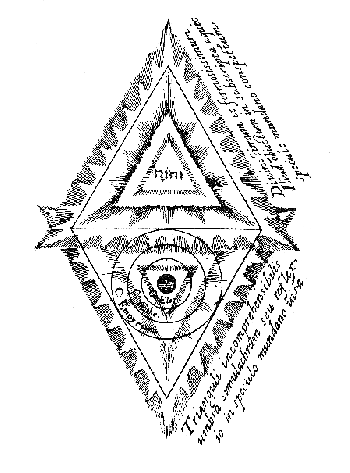
"The image [above]
The caption of the
'That most divine and beautiful
The caption of the
'A shadow, likeness, or * Sic. The original is incomprehensibilis, a technical theological term. See Dorothy Sayers on the Athanasian Creed and John 1:5. |
For further iconology of the
above equilateral triangles,
see Star Wars (May 25, 2003),
Mani Padme (March 10, 2008),
Rite of Sping (March 14, 2008),
and
Art History: The Pope of Hope
(In honor of John Paul II
three days after his death
in April 2005).
Happy Shakespeare's Birthday.
Monday, April 7, 2008
Monday April 7, 2008
“Lord Arglay had a suspicion that
— Charles Williams, Many Dimensions
Monday, July 23, 2007
Monday July 23, 2007
is 18 today.

Greetings.
“The greatest sorcerer (writes Novalis memorably)
would be the one who bewitched himself to the point of
taking his own phantasmagorias for autonomous apparitions.
Would not this be true of us?”
–Jorge Luis Borges, “Avatars of the Tortoise”
“El mayor hechicero (escribe memorablemente Novalis)
sería el que se hechizara hasta el punto de
tomar sus propias fantasmagorías por apariciones autónomas.
¿No sería este nuestro caso?”
–Jorge Luis Borges, “Los Avatares de la Tortuga“
At Midsummer Noon:
|
|
It is not enough to cover the rock with leaves. We must be cured of it by a cure of the ground Or a cure of ourselves, that is equal to a cure
Of the ground, a cure beyond forgetfulness.
And if we ate the incipient colorings – Wallace Stevens, “The Rock” |
Gödel and Escher and Bach
were only shadows
cast in different directions by
some central solid essence.
I tried to reconstruct
the central object, and
came up with this book.”

Hofstadter’s cover.
“shadows” of a sort,
derived from a different
“central object”:
Sunday, June 24, 2007
Sunday June 24, 2007
the Lost Stone
(Continued from June 23)

Related material:

The Klein Correspondence,
Penrose Space-Time,
and a Finite Model
Friday, February 2, 2007
Friday February 2, 2007
The Night Watch
For Catholic Schools Week
(continued from last year)–
Last night's Log24 Xanga
footprints from Poland:
Poland 2/2/07 1:29 AM
/446066083/item.html
2/20/06: The Past Revisited
(with link to online text of
Many Dimensions, by Charles Williams)
Poland 2/2/07 2:38 AM
/426273644/item.html
1/15/06 Inscape
(the mathematical concept, with
square and "star" diagrams)
Poland 2/2/07 3:30 AM
nextdate=2%252f8%252f20…
2/8/05 The Equation
(Russell Crowe as John Nash
with "star" diagram from a
Princeton lecture by Langlands)
Poland 2/2/07 4:31 AM
/524081776/item.html
8/29/06 Hollywood Birthday
(with link to online text of
Plato on the Human Paradox,
by a Fordham Jesuit)
Poland 2/2/07 4:43 AM
/524459252/item.html
8/30/06 Seven
(Harvard, the etymology of the
word "experience," and the
Catholic funeral of a professor's
23-year-old daughter)
Poland 2/2/07 4:56 AM
/409355167/item.html
12/19/05 Quarter to Three (cont.)
(remarks on permutation groups
for the birthday of Helmut Wielandt)
Poland 2/2/07 5:03 AM
/490604390/item.html
5/29/06 For JFK's Birthday
(The Call Girls revisited)
Poland 2/2/07 5:32 AM
/522299668/item.html
8/24/06 Beginnings
(Nasar in The New Yorker and
T. S. Eliot in Log24, both on the 2006
Beijing String Theory conference)
Poland 2/2/07 5:46 AM
/447354678/item.html
2/22/06 In the Details
(Harvard's president resigns,
with accompanying "rosebud")
Monday, February 20, 2006
Monday February 20, 2006
The Past Revisited
From Log24 a year ago on this date, a quote from Many Dimensions (1931), by Charles Williams:
“Lord Arglay had a suspicion that the Stone would be purely logical. Yes, he thought, but what, in that sense, were the rules of its pure logic?”
For the rest of the story, see the downloadable version at Project Gutenberg of Australia.
Monday, August 22, 2005
Monday August 22, 2005
Apostolos Doxiadis on last month's conference on "mathematics and narrative"–
Doxiadis is describing how talks by two noted mathematicians were related to
"… a sense of a 'general theory bubbling up' at the meeting… a general theory of the deeper relationship of mathematics to narrative…. "
Doxiadis says both talks had "a big hole in the middle."
"Both began by saying something like: 'I believe there is an important connection between story and mathematical thinking. So, my talk has two parts. [In one part] I’ll tell you a few things about proofs. [And in the other part] I’ll tell you about stories.' …. And in both talks it was in fact implied by a variation of the post hoc propter hoc, the principle of consecutiveness implying causality, that the two parts of the lectures were intimately related, the one somehow led directly to the other."
"And the hole?"
"This was exactly at the point of the link… [connecting math and narrative]… There is this very well-known Sidney Harris cartoon… where two huge arrays of formulas on a blackboard are connected by the sentence ‘THEN A MIRACLE OCCURS.’ And one of the two mathematicians standing before it points at this and tells the other: ‘I think you should be more explicit here at step two.’ Both… talks were one half fascinating expositions of lay narratology– in fact, I was exhilarated to hear the two most purely narratological talks at the meeting coming from number theorists!– and one half a discussion of a purely mathematical kind, the two parts separated by a conjunction roughly synonymous to ‘this is very similar to this.’ But the similarity was not clearly explained: the hole, you see, the ‘miracle.’ Of course, both [speakers]… are brilliant men, and honest too, and so they were very clear about the location of the hole, they did not try to fool us by saying that there was no hole where there was one."
"At times, bullshit can only be countered with superior bullshit."
— Norman Mailer
Many Worlds and Possible Worlds in Literature and Art, in Wikipedia:
"The concept of possible worlds dates back to a least Leibniz who in his Théodicée tries to justify the apparent imperfections of the world by claiming that it is optimal among all possible worlds. Voltaire satirized this view in his picaresque novel Candide….
Borges' seminal short story El jardín de senderos que se bifurcan ("The Garden of Forking Paths") is an early example of many worlds in fiction."
Background:
Modal Logic in Wikipedia
Possible Worlds in Wikipedia
Possible-Worlds Theory, by Marie-Laure Ryan
(entry for The Routledge Encyclopedia of Narrative Theory)
'…It is told that, when the Merciful One made the worlds, first of all He created that Stone and gave it to the Divine One whom the Jews call Shekinah, and as she gazed upon it the universes arose and had being.'"
— Many Dimensions, by Charles Williams, 1931 (Eerdmans paperback, April 1979, pp. 43-44)
"The lapis was thought of as a unity and therefore often stands for the prima materia in general."
— Aion, by C. G. Jung, 1951 (Princeton paperback, 1979, p. 236)
"Its discoverer was of the opinion that he had produced the equivalent of the primordial protomatter which exploded into the Universe."
|
"We symbolize
logical necessity with the box and logical possibility with the diamond
"The possibilia that exist,
— Michael Sudduth, |
Tuesday, March 22, 2005
Tuesday March 22, 2005
The God Factor
"Kids who may never get out of their town will be able to see the world through books. But I'm talking about my passion. What's yours?"
— NickyJett, Xanga comment
"'What is this Stone?' Chloe asked….
'…It is told that, when the Merciful One
made the worlds, first of all He created
that Stone and gave it to the Divine One
whom the Jews call Shekinah,
and as she gazed upon it
the universes arose and had being.'"
— Many Dimensions,
by Charles Williams, 1931
appropriate to Passion Week —
Jews playing God — see

Rebecca Goldstein
in conversation with
Bob Osserman
of the
Mathematical Sciences Research Institute
at the Commonwealth Club, San Francisco,
Tuesday, March 22. Wine and cheese
reception at 5:15 PM (San Francisco time).
For the meaning of the diamond,
see the previous entry.
Sunday, February 20, 2005
Sunday February 20, 2005
Relativity Blues
Today, February 20, is the 19th anniversary of my note The Relativity Problem in Finite Geometry. Here is some related material.
In 1931, the Christian writer Charles Williams grappled with the theology of time, space, free will, and the many-worlds interpretation of quantum mechanics (anticipating by many years the discussion of this topic by physicists beginning in the 1950's).
(Some pure mathematics — untainted by physics or theology — that is nevertheless related, if only by poetic analogy, to Williams's 1931 novel, Many Dimensions, is discussed in the above-mentioned note and in a generalization, Solomon's Cube.)
On the back cover of Williams's 1931 novel, the current publisher, William B. Eerdmans Publishing Company of Grand Rapids, Michigan, makes the following statement:
"Replete with rich religious imagery, Many Dimensions explores the relation between predestination and free will as it depicts different human responses to redemptive transcendence."
One possible response to such statements was recently provided in some detail by a Princeton philosophy professor. See On Bullshit, by Harry G. Frankfurt, Princeton University Press, 2005.
A more thoughtful response would take into account the following:
1. The arguments presented in favor of philosopher John Calvin, who discussed predestination, in The Death of Adam: Essays on Modern Thought, by Marilynne Robinson
2. The physics underlying Einstein's remarks on free will, God, and dice
3. The physics underlying Rebecca Goldstein's novel Properties of Light and Paul Preuss's novels Secret Passages and Broken Symmetries
4. The physics underlying the recent so-called "free will theorem" of John Conway and Simon Kochen of Princeton University
5. The recent novel Gilead, by Marilynne Robinson, which deals not with philosophy, but with lives influenced by philosophy — indirectly, by the philosophy of the aforementioned John Calvin.
From a review of Gilead by Jane Vandenburgh:
"In The Death of Adam, Robinson shows Jean Cauvin to be the foremost prophet of humanism whose Protestant teachings against the hierarchies of the Roman church set in motion the intellectual movements that promoted widespread literacy among the middle and lower classes, led to both the American and French revolutions, and not only freed African slaves in the United States but brought about suffrage for women. It's odd then that through our culture's reverse historicism, the term 'Calvinism' has come to mean 'moralistic repression.'"
For more on what the Calvinist publishing firm Eerdmans calls "redemptive transcendence," see various July 2003 Log24.net entries. If these entries include a fair amount of what Princeton philosophers call bullshit, let the Princeton philosophers meditate on the summary of Harvard philosophy quoted here on November 5 of last year, as well as the remarks of November 5, 2003, and those of November 5, 2002.
From Many Dimensions (Eerdmans paperback, 1963, page 53):
"Lord Arglay had a suspicion that the Stone would be purely logical. Yes, he thought, but what, in that sense, were the rules of its pure logic?"
A recent answer:
"We symbolize logical necessity
with the box ![]() )
)
and logical possibility
with the diamond ![]() ).
).
— Keith Allen Korcz,
(Log24.net, 1/25/05)
And what do we
symbolize by ![]() ?
?
"The possibilia that exist,
and out of which
the Universe arose,
are located in
a necessary being…."
— Michael Sudduth,
Notes on
God, Chance, and Necessity
by Keith Ward,
Regius Professor of Divinity
at Christ Church College, Oxford
(the home of Lewis Carroll)
Thursday, February 17, 2005
Thursday February 17, 2005
"We symbolize logical necessity
with the box ![]() )
)
and logical possibility
with the diamond ![]() ).
).
— Keith Allen Korcz,
(Log24.net, 1/25/05)
And what do we
symbolize by ![]() ?
?
On the Lapis Philosophorum,
the Philosophers' Stone –
"'What is this Stone?' Chloe asked….
'…It is told that, when the Merciful One
made the worlds, first of all He created
that Stone and gave it to the Divine One
whom the Jews call Shekinah,
and as she gazed upon it
the universes arose and had being.'"
– Many Dimensions,
by Charles Williams, 1931
(Eerdmans paperback,
April 1979, pp. 43-44)
"The lapis was thought of as a unity
and therefore often stands for
the prima materia in general."
– Aion, by C. G. Jung, 1951
(Princeton paperback,
1979, p. 236)
"Its discoverer was of the opinion that
he had produced the equivalent of
the primordial protomatter
which exploded into the Universe."
– The Stars My Destination,
by Alfred Bester, 1956
(Vintage hardcover,
July 1996, p. 216)
"The possibilia that exist,
and out of which
the Universe arose,
are located in
a necessary being…."
— Michael Sudduth,
Notes on
God, Chance, and Necessity
by Keith Ward,
Regius Professor of Divinity
at Christ Church College, Oxford
(the home of Lewis Carroll)
See also
The Diamond Archetype.
For more on modal theology, see
Kurt Gödel's Ontological Argument
and
The Ontological Argument
from Anselm to Gödel.
Friday, September 19, 2003
Friday September 19, 2003
The Mysteries of 26
My entry of May 26, 2003 —
dealt with the question of whether this number, said to be of significance (as a number of dimensions) in theoretical physics, has any purely mathematical properties of interest.

That entry contained the above figure, a so-called Levi graph illustrating point/line incidence in the finite projective plane with 13 points and 13 lines, PG(2,3).
It turns out that in a paper of April 7, 2000, John H. Conway and Christopher S. Simons discussed a close connection between this plane and the Monster group. See
(Journal of Algebra. Vol. 235, no. 2.
MR 2001k:20028).
Conway had written about such a connection as early as 1985.
I apologize for not knowing about this sooner, and so misleading any mathematical readers about the number 26, which it seems does have considerable purely mathematical significance.
Monday, May 26, 2003
Monday May 26, 2003
Mental Health Month, Day 26:
Part III — Why 26?
At first blush, it seems unlikely that the number 26=2×13, as a product of only two small primes (and those distinct) has any purely mathematical properties of interest. (On the other hand, consider the number 6.) Parts I and II of “Many Dimensions,” notes written earlier today, deal with the struggles of string theorists to justify their contention that a space of 26 dimensions may have some significance in physics. Let them struggle. My question is whether there are any interesting purely mathematical properties of 26, and it turns out, surprisingly, that there are some such properties. All this is a longwinded way of introducing a link to the web page titled “Info on M13,” which gives details of a 1997 paper by J. H. Conway*.
|
“Conway describes the beautiful construction of a discrete mathematical structure which he calls ‘ Why do the simple groups In fact, both the Mathieu group To understand the definition of The points and the lines and the “is-contained-in” relation form an incidence structure over …the 26 objects of the incidence structure [are] 13 points and 13 lines.”
Conway’s construction involves the arrangement, in a circular Levi graph, of 26 marks representing these points and lines, and chords representing the “contains/is contained in” relation. The resulting diagram has a pleasingly symmetric appearance. For further information on the geometry of the number 26, one can look up all primitive permutation groups of degree 26. Conway’s work suggests we look at sets (not just groups) of permutations on n elements. He has shown that this is a fruitful approach for n=13. Whether it may also be fruitful for n=26, I do not know. |
There is no obvious connection to physics, although the physics writer John Baez quoted in my previous two entries shares Conway’s interest in the Mathieu groups.
* J. H. Conway, “M13,” in Surveys in Combinatorics, 1997, edited by R. A. Bailey, London Mathematical Society Lecture Note Series, 241, Cambridge University Press, Cambridge, 1997. 338 pp. ISBN 0 521 59840 0.
Monday May 26, 2003
Mental Health Month, Day 26:
Many Dimensions,
Part II — The Blue Matrix
But seriously…
John Baez in July 1999:
"…it's really the fact that the Leech lattice is 24-dimensional that lets us compactify 26-dimensional spacetime in such a way as to get a bosonic string theory with the Monster group as symmetries."
Well, maybe. I certainly hope so. If the Leech lattice and the Monster group turn out to have some significance in theoretical physics, then my own work, which deals with symmetries of substructures of the Leech lattice and the Monster, might be viewed in a different light. Meanwhile, I take (cold) comfort from some writers who pursue the "story" theory of truth, as opposed to the "diamond" theory. See the following from my journal:
Evariste Galois and the Rock that Changed Things, and
A Time to Gather Stones Together: Readings for Yom Kippur.
See, too, this web page on Marion Zimmer Bradley's fictional
Matrices, or Blue Star-Stones, and

the purely mathematical site Diamond Theory, which deals with properties of the above "blue matrix" and its larger relatives.
Monday May 26, 2003
Mental Health Month, Day 26:
John Baez on why bosonic string theory is said to require 26 dimensions —
“By now, if you’re a rigorous sort of pure mathematician, you must be suffering from grave doubts about the sanity of this whole procedure.”
Doubts? Let us just say I prefer
“The G-string is unique in that it combines the properties of all known string theories. It has 26-dimensional modes propagating to the left, 10-dimensional modes propagating to the right, and 2-dimensional modes just sitting around wondering what the hell is going on.”
Friday, January 3, 2003
Friday January 3, 2003
| Tolkien is Eleventy-One Today! | 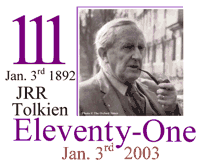 |
In observance of this milestone, some links:
- The Tolkien Society’s Birthday Toast 2003
- Inklings Resources and Site List
- Review of Humphrey Carpenter’s The Inklings
- Alt.books.inklings newsgroup
- Humphrey Carpenter’s The Inklings
- Timothy R. O’Neill’s The Individuated Hobbit
- Tolkien and subcreation: “On Fairy Stories” in The Monsters and the Critics
- Dorothy Sayers’s The Mind of the Maker
- Dorothy Sayers’s defense of the traditional seven liberal arts in A Matter of Eternity
- C. S. Lewis’s defense of traditional values and “the Tao” in The Abolition of Man
- Charles Williams’s Many Dimensions, which deals in part with another magical ring.
Monday, September 16, 2002
Monday September 16, 2002
A Time to Gather Stones Together
(Ecclesiastes 3:5)
Readings for Yom Kippur:
- "Stones," from Jewish Heritage Online Magazine
- "The Foundation Stone: The Center of Creation," from Jewish Heritage Online Magazine
- Many Dimensions, a novel by Charles Williams































